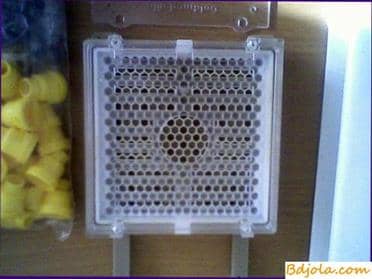
Postage of the queens by mail is made in special cells that have 2 compartments: one for bees and a uterus and the second for a smaller one – forage. The stern compartment of the cage is covered with a thin layer of wax before laying the feed into it, which protects the feed from drying out and absorbing the cell with a tree and then is filled with fodder (kandi). Kandy is loosely covered with a piece of parchment or wax paper. In addition, a common metal mesh is superimposed on the recesses of the cell.
At present, when preparing for shipment, the queens are often supplied with food not as candy, which contains very little water, but in the form of mature, mostly printed honey, which is given along with a piece of honeycomb. The transfer of the queens with such food is more successful, as the uterus and bees suffer less from thirst.
Usually the uterus and transferred bees (10-15 pieces) are allowed through the hole. Then the cell is securely sealed. The cover designates “Live bees” and the address is written.
Дезинфекция пчелиных сотов. Паратиф у пчел.
Mothers and uterus